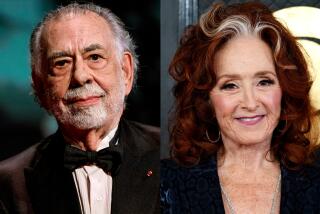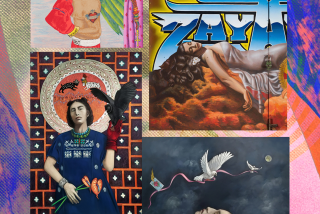Bringing out the artists behind the art
The idea behind the 2-year-old USA Fellows awards is to improve the Q ratings of American artists who live in a universe apart from Q ratings -- doing what they do less for riches and stardom than for art’s sake.
The 50 winners announced today by the L.A.-based nonprofit group United States Artists will receive $50,000 each as well as lapel pins with the motto “Art comes from artists,” with the prizes to be bestowed at a ceremony Saturday at Paramount Studios.
The winners are, by design, a group devoid of household names. The “Art comes from artists” slogan, like the awards themselves, was motivated by an Urban Institute survey published in 2003 showing that although 96% of Americans said they had been moved or inspired by a work of art, only 27% regarded artists as contributing “a lot” to society.
“Even when the artist’s work is recognized as valuable . . . the artist who made it is often invisible,” the researchers concluded.
So foundations that support the arts -- including Ford, Rockefeller and Prudential -- anted up $20 million to seed an annual cash award in hopes it would become both a boon to unsung masters picked by panels of experts and a public relations salvo aimed at winning respect for all artists.
The fellowships are awarded in eight disciplines: architecture and design, crafts and traditional arts, dance, literature, media, music, theater arts and visual arts.
Along with relative unknowns, the 2007 recipients include artists whose careers have been honored but mostly outside the purview of commercial television and celebrity culture -- among them choreographer Bill T. Jones, pioneering Chicano playwright Luis Valdez (“Zoot Suit”), jazz clarinetist Don Byron, Cajun fiddler Michael Doucet, classical violinist Leila Josefowicz, and veteran theater directors Tina Landau, Elizabeth LeCompte and Robert Woodruff.
Reflecting L.A.’s standing as a center for visual arts, six of the 10 winners in that category are based in Southern California. Edgar Arceneaux, Uta Barth, Charles Gaines, Daniel Joseph Martinez and Allan Sekula are from L.A., and Marcos Ramirez, also known as “Erre,” has had a border-straddling career based in Tijuana and San Ysidro. Last year, four of 12 visual arts fellows were from Southern California.
Other Southern California winners are Los Angeles architectural partners Benjamin Ball and Gaston Nogues of Ball-Nogues Studio, who will split a single $50,000 prize; Marilyn Chin, a San Diego poet; and L.A. filmmaker Julie Dash.
The winners come from 15 states and range in age from Josefowicz, 30, to Bay Area choreographer Anna Halprin, 87.
If United States Artists is trying to launch a public relations revolution for the arts, however, it still has not gained the fundamental foothold of having its event televised.
“It’s something we would love to do, but it’s just our second year,” said executive director Katharine DeShaw. For now, she said, Target Corp. is helping to get out the word by buying full-page newspaper ads in major cities congratulating the winners. In addition, documentary filmmaker Phillip Rodriguez, one of last year’s winners, is producing short videos on the 2007 fellows, and students from USC’s Annenberg School for Communication have been hired to “infiltrate” them onto prominent Internet sites.
Eli Broad, Agnes Gund, Target and Prudential each funded five of this year’s fellowships with donations of $250,000 apiece. In all, 36 of this year’s prizes were provided by donors, up from 23 last year, allowing the young organization to conserve most of its start-up funding for future initiatives.
In the selection process, DeShaw said, about 200 nominators -- knowledgeable people from across the country -- were asked to put two names in the hat, leaving out prominent figures such as Wynton Marsalis who have crossed over to fame and fortune. Five-member panels in each discipline decided the winners.
Still in the talking stages: a biennial conference aimed at projecting USA fellows further into the public eye as advocates for the arts and arts education.
“Artists are down in the polls,” DeShaw said, citing low levels of public arts funding and “abysmal” neglect of arts education in public schools. “A friend of mine was saying ‘You love the painting on the wall, but you don’t want the artist in the living room.’ . . . One of our goals is to turn that around.”
More to Read
The biggest entertainment stories
Get our big stories about Hollywood, film, television, music, arts, culture and more right in your inbox as soon as they publish.
You may occasionally receive promotional content from the Los Angeles Times.











